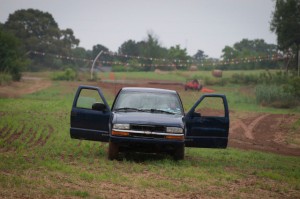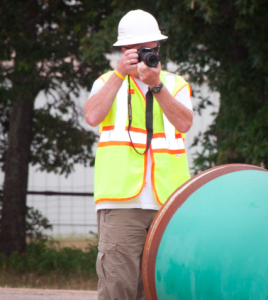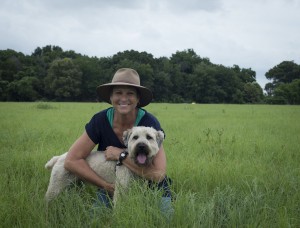Michael Bishop flies three flags on his East Texas farm: a red US Marine Corps flag, the yellow Gadsden flag with a coiled snake that reads, “Don’t Tread On Me,” and a faded, red, white and blue Old Glory — the last of which hangs upside down. “Someone said this was disrespecting the American flag,” said Bishop. “But I read the US code to them. This is perfectly legal under federal law: It means my property is in distress.”

Michael Bishop displays one of the flags he flies upside down on his property in Douglass, Texas, because it's "in distress," he says. Photo: Tara Lohan.
Bishop, 65, a Marine veteran, former paramedic, chemist, biofuels producer and now a first-year medical school student, doesn’t back down from a fight. Right now he’s locked horns with TransCanada, the Canadian pipeline company that’s responsible for another set of flags on Bishop’s property — two ropes of colorful triangular ones strung between poles that look like they should be adorning a used car lot instead of a rural property. These, however, are the common markings of a pipeline route.
By eminent domain, TransCanada seized part of Bishop’s 20 acres near Nacogdoches for construction of the Keystone XL pipeline, which the company insisted needed to be built right through his orchard and garden. Beyond the flags is the long gash in question, which in the rain and oozing red Texas mud looks like a gaping wound.
You’ve likely heard something of the controversy over the pipeline, which would carry a thick slurry of diluted bitumen (or dilbit) from Alberta’s tar sands to Gulf Coast refineries near Houston. Five years ago its construction was all but a done deal, only lacking the official nod from the Obama administration, necessary since the planned route crosses the US-Canada border.
While McKibben and friends took center stage in the capitol, local protests against the pipeline route emerged in the heartland. Pissed-off Nebraska farmers have given the administration pause. At a June 2013 speech at Georgetown University, Obama said that he would only approve the pipeline if it didn’t exacerbate climate pollution.
Pipeline opponents celebrated the speech as a hopeful sign that the project would never come to fruition. But Michael Bishop and other landowners across a 485-mile strip of Oklahoma and Texas had already had their dreams dashed and their land condemned, cleared and bulldozed. And that’s because the pipeline has a northern and a southern leg. Only the fate of the northern leg remains undecided. Just a year before his Georgetown speech, Obama stood in Cushing, Okla., in front of a pile of pipeline and said, “The southern leg of it, we’re making a priority.”

Flags marking the Keystone XL pipeline on Michael Bishop's property in Douglass, Texas. Photo: Tara Lohan.
Cushing itself is not much to look at: Its downtown is like a ghost town, with vacant storefronts and boarded-up windows — a far cry from its days as a bustling oil refinery center. But the town still boasts of being the “pipeline crossroads of the world.” It already hosts a terminus of the Keystone pipeline — the elder sibling of sorts to the Keystone XL, which was completed in 2011. Obama fast-tracked the southern leg of Keystone XL to help move crude out of Cushing and toward the Gulf, where it can be refined and perhaps exported.
For Julia Trigg Crawford, Obama’s decision felt like being thrown under the bus. “It’s almost like they built this thing in Texas and Oklahoma under the cover of darkness,” said Crawford, who manages her family’s 650-acre farm near Paris, Texas.
The Keystone XL’s southern leg officially opens today. Soon, 700,000 barrels of oil will be pulsing underneath Crawford’s land each day, potentially increasing to 830,000 barrels a day in the future. As for its soundness, TransCanada’s track record doesn’t put Crawford at ease. A report by consumer advocacy organization Public Citizen found that during construction of the southern leg, “landowners and observers documented dozens of anomalies and problems apparently caused by TransCanada contractors not following the mandated engineering code.”
Residents of Mayflower, Ark., found that out the hard way last year when their suburban neighborhood was inked with 200,000 gallons of toxic black goo from a broken dilbit pipeline. It was also a lesson that schooled Marshall, Mich., in 2010 when close to a million gallons of dilbit spilled into the Kalamazoo River from a fractured pipeline. Years later, the river and the community still haven’t fully recovered.
Crawford doesn’t want to see Texas and Oklahoma added to the list of sacrificed areas. “Why is the northern leg something we need to think a little bit more about but not the southern leg?” she asked. “Why are there two standards? The same material that’s coming through the northern leg will be coming through the southern leg.” And why, for that matter, is the president concerned about the impact of the project on climate change from one half of the pipeline but not the other?
Like Bishop’s, part of Crawford’s family farm was taken by eminent domain for construction of the pipeline after her family refused to sign a deal with the company. You’d think a foreign corporation trying to seize property from Texas farmers would be in for a tough fight, since the state prides itself on private property rights — but seizure is actually a cinch. TransCanada just has to check a box on a form to the Texas Railroad Commission (the state body regulating pipelines) affirming that it is a “common carrier” (which means that other companies can use the pipeline “for hire,” so it’s theoretically for the public good).

A Keystone XL worker takes photos of Julia Trigg Crawford while she walks on her farm. Photo: Tara Lohan.
If a landowner wants to challenge the designation of ‘common carrier,’ he or she must be willing to shell out big bucks and face off against a major multinational in court. It’s costly, and there’s no assurance of victory. But, like Bishop, Crawford is not one to back down from a fight. “We don’t think someone should have more of a right to our land than we do,” said Crawford. “Also this farm houses a very well-recognized Caddo Indian burial site. So we are protecting the artifacts, protecting our water and standing up for our rights.”
With a legal defense fund spurred by donations, Crawford put up her dukes. And for that, she’s been treated like a criminal. She’s photographed and filmed by industry folks when she’s walking on her own land, and the pipeline on her property is staffed with security around the clock — most of whom are off-duty local law enforcement.
Crawford has faced it all with civility and a steely determination. Right now she’s on pins and needles, hoping the Texas Supreme Court will agree to hear her case against TransCanada, which has shuffled up the legal pathways of her state for the last few years.
She and Bishop (who is representing himself in lawsuits against the company and the Army Corps of Engineers over the pipeline) were given hope by a recent decision made by the Texas Supreme Court. In Texas Rice Land Partners v. Denbury Green Pipeline-Texas, the court ruled that private property is constitutionally protected, and “a private enterprise cannot acquire condemnation power merely by checking boxes on a one-page form.” The Denbury decision however, was about a natural gas pipeline, and not the Keystone XL.
To say that their fight is one of David vs. Goliath would be an understatement. The deck has been stacked against them from the start, and the interests at stake go well beyond just TransCanada. Review of the northern section of the pipeline, the fate of which remains up in the air, has been mired in controversy. For starters, TransCanada’s director of government relations, Paul Elliot, was also the national deputy director for Hillary Clinton’s 2008 run for president. And Clinton was heading the State Department when the agency began reviewing the pipeline’s environmental impact.
The draft environmental impact statement that the State Department reviewed was not done by the agency itself but by a contractor, Environmental Resources Management, and paid for by TransCanada itself. Contractors who worked on the statement also worked on previous TransCanada pipelines as well as for companies such as ExxonMobil, Shell, BP and Koch Gateway Pipeline Company — all of whom could benefit from the project. It was later found that the State Department intentionally kept the public in the dark about the connections. To make matters worse, Environmental Resources Management is listed as a member of industry groups such as the American Petroleum Institute, Western Energy Alliance, and the American Fuel and Petrochemical Manufacturers. Conflict of interest?
Besides the obvious advantages to TransCanada, Koch Industries may also win big from the project. As the second-largest private company in the country, it’s a heavy hitter. The Kochs claim they don’t have any connection with the pipeline but, “Koch Industries has touched virtually every aspect of the tar sands industry since the company established a toehold in Canada more than 50 years ago,” wrote David Sassoon for Inside Climate News. “It has been involved in mining bitumen, the hydrocarbon resin found in the oil sands; in pipeline systems to collect and transport Canadian crude; in exporting the heavy oils to the US; in refining the sulfurous, low-grade feedstock and in the subsequent distribution and sale of a variety of finished products from jet fuel to asphalt.”
Dark money is increasingly becoming the name of the game. A studyby Robert J. Brulle at Drexel University found that right-wing organizations, such as those supported by the Kochs to counter climate change action, are increasingly using “donor directed philanthropies” such as Donors Trust and Donor Capital to cover their tracks because such donations don’t need to be made public. “In effect, these two philanthropic foundations form a black box that conceals the identity of contributors,” writes Brulle. The use of such foundations for anonymous giving is on the rise: Donors Trust doled out $1.2 million in 2002 to conservative causes and increased its offerings to $63 million by 2010.
Whether it’s coming from the Kochs or someone else, big money is invested in enabling the fossil fuel kings to remain on their thrones. Stopping TransCanada will be virtually impossible for Crawford and Bishop, but that doesn’t mean they won’t keep trying.
Every day that her court case remains alive is a day Crawford says she can help continue the conversation about the risks that her community, and others along the pipeline, may face. “I have very little hope we are going to win — we’re outmanned, outfinanced,” said Crawford. “But there is this groundswell of people saying that until someone stands up nothing is going to change. We’re staying in the game even though it’s a long shot. We’re shining a light on it for some discussion.
“I’ve never been an activist — but I am now — an accidental activist,” said Crawford. “I never really rocked the boat — first-born, Girl Scout, cheerleader. I never really got in trouble until now. It’s like sometimes you have to color outside the lines a bit.”
TransCanada drew its line in the red dirt. And Crawford has drawn hers. Win or lose, a powerful force has awoken in Texas.



